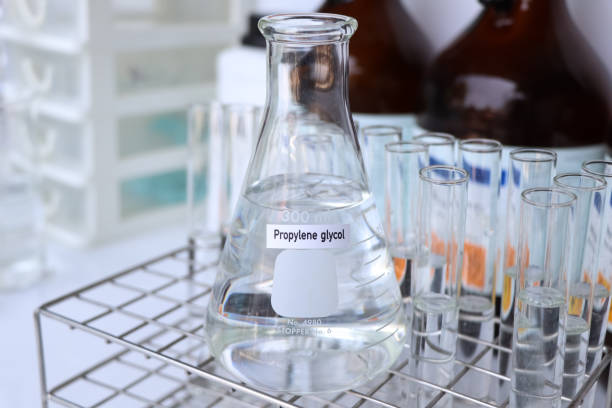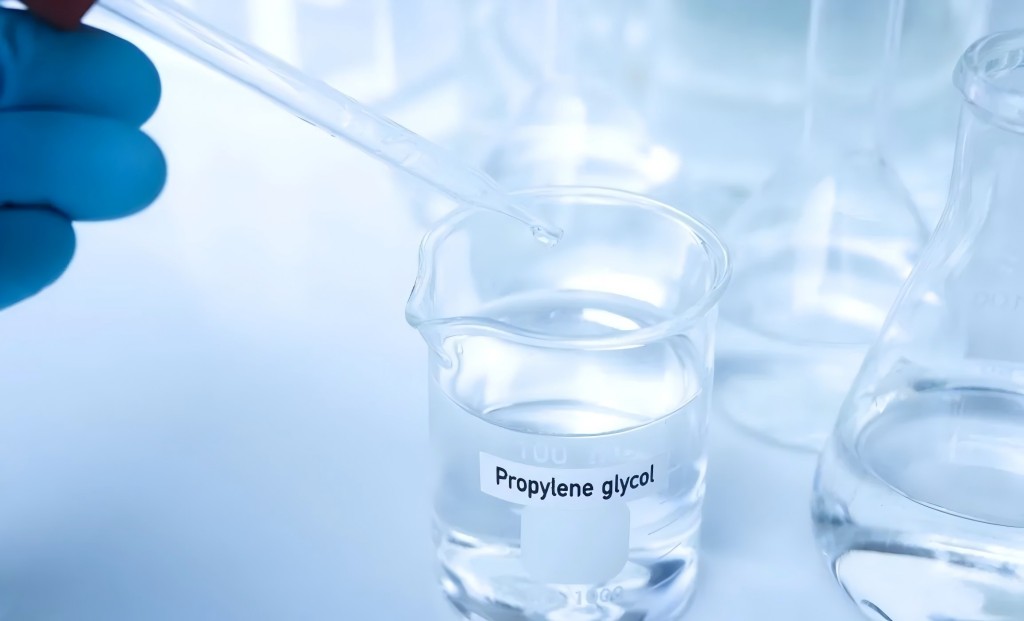A synthetic substance, propylene glycol (PG) finds use in a wide range of industries, from pharmaceuticals and industrial goods to food and cosmetics. Its extensive use frequently prompts questions over its safety, particularly when it comes into touch with people. This article will explore the various aspects of propylene glycol, its safety, potential health risks, and the regulatory measures surrounding its use.

What is Propylene Glycol?
Propylene glycol is a colorless, odorless, and tasteless liquid that absorbs water from its surroundings because it is hygroscopic. It is frequently made by hydrating propylene oxide, a byproduct of refining petroleum. Due to its versatility, this molecule can be found in a wide range of items, including antifreeze, food additives, medications, and cosmetics.
Chemical Structure:
- Chemical formula: C₃H₈O₂
- Molecular weight: 76.09 g/mol
- Structure: A simple diol with two hydroxyl groups (-OH)
Despite being synthetically manufactured, propylene glycol is relatively safe for human exposure under normal conditions, which is why it is approved for use in various consumer products.

Uses of Propylene Glycol
Propylene glycol is used in many different industries. An outline of its typical applications is provided below:
| Industry | Common Uses |
| Food | Used as a food additive (E1520), solvent for flavorings, and humectant (moisture-retaining agent). |
| Cosmetics | Found in skincare products, lotions, shampoos, and deodorants to retain moisture and stabilize formulas. |
| Pharmaceuticals | Used as a solvent in oral, injectable, and topical medicines. |
| Industrial | Employed in antifreeze, de-icers, and hydraulic fluids due to its low freezing point. |
| Vaping | Common in e-liquids as a base for vaporizing. |
The versatility of propylene glycol is one of the reasons it has found such widespread use across many products.
Safety and Regulatory Status
When it comes to human consumption and contact, propylene glycol is regarded as relatively safe. The U.S. Food and Drug Administration (FDA) is one of several health agencies that have assessed the compound’s safety profile.
FDA Approval:
- Propylene glycol is a chemical that the FDA has designated as Generally Recognized as Safe (GRAS) for use as a food additive and in food products. This indicates that PG is regarded as safe for human ingestion at normal usage levels.
- It has also been approved for use in pharmaceuticals and cosmetics, though usage concentrations are regulated to prevent any adverse effects.
European Food Safety Authority (EFSA):
- The EFSA similarly deems propylene glycol safe for human consumption, with acceptable daily intake limits in food set at 25 mg per kilogram of body weight.
- Despite these regulatory approvals, safety concerns arise mainly from overexposure or certain health conditions.
Potential Health Risks of Propylene Glycol
While propylene glycol is generally safe, there are potential health risks associated with its use, especially in excessive amounts or in individuals with specific health conditions.
1. Skin and Eye Irritation:
- Prolonged or high-level exposure to propylene glycol can cause irritation to the skin and eyes. This is typically a concern when PG is used in concentrated forms, such as in industrial applications or certain cosmetics.
- Feelings of redness, itching, or burning are examples of irritation symptoms.
2. Allergic Reactions:
- Although they are uncommon, allergic reactions to propylene glycol can happen to certain people. From minor rashes to more serious symptoms including breathing difficulties, edema, and anaphylaxis, these reactions can take many different forms.
- Individuals with a known allergy to propylene glycol should avoid products containing the compound.
3. Inhalation Risks (Vaping):
- Propylene glycol is often used in e-cigarettes and vaping liquids. Although propylene glycol is safe to consume and apply topically, its long-term consequences from inhalation are yet unclear.
- Some studies have raised concerns about the potential for respiratory irritation or other adverse effects with long-term exposure to vaporized PG.
4. Toxicity in High Concentrations:
- Ingesting large amounts of propylene glycol (much higher than typical food or pharmaceutical concentrations) can cause toxicity. Symptoms may include nausea, vomiting, and in extreme cases, kidney damage or neurological effects.
- But this kind of toxicity is highly uncommon and usually only happens when very high dosages are used.
Are Certain Populations Safe to Use Propylene Glycol?
Some demographics might be more susceptible to propylene glycol’s negative effects. Below is an analysis of how specific populations are affected by exposure.
| Population | Safety Considerations |
| Children | Safe in small doses. Overexposure through medications or cosmetics may cause mild irritation or allergic reactions. |
| Pregnant Women | PG is classified as safe during pregnancy. However, it is advised to limit unnecessary exposure. |
| Individuals with Kidney or Liver Disease | Those with compromised kidney or liver function should limit their exposure to high concentrations of PG, as it may be harder for their body to metabolize. |
| Asthma Patients | May experience increased irritation or respiratory discomfort due to inhaling PG vapors, especially from e-cigarettes. |
While propylene glycol is generally safe, sensitive individuals should take care to avoid overexposure, especially in more concentrated forms.
Toxicity and Overexposure
Propylene glycol is considered low toxicity. It is typically metabolized by the liver and excreted through the kidneys. On the other hand, it can build up in the body and result in toxic effects if taken in excess.
Here are some potential signs of propylene glycol overexposure:
| Symptom | Description |
| Nausea and Vomiting | Can occur when large amounts of PG are ingested. |
| Dizziness or Headaches | High concentrations of PG can lead to neurological effects. |
| Kidney or Liver Issues | Extended exposure to excessive amounts may lead to organ stress, particularly in individuals with pre-existing conditions. |
As with any chemical, following recommended guidelines and concentrations ensures the safe use of propylene glycol.
Alternatives to Propylene Glycol
For those concerned about potential risks associated with propylene glycol, several alternatives are available. These include:
| Alternative Compound | Uses | Pros |
| Vegetable Glycerin (VG) | Used in e-liquids, cosmetics, and pharmaceuticals | Natural, less likely to cause irritation or allergies |
| Ethylene Glycol (EG) | Found in antifreeze and de-icers | More toxic than propylene glycol, so less commonly used in consumer products |
| Polyethylene Glycol (PEG) | Used in pharmaceutical products and personal care | Similar to PG but with a higher molecular weight and longer metabolism time |
Each of these alternatives comes with its own set of safety profiles, so it’s essential to consider them based on the intended use and health concerns.
Conclusion
Propylene glycol is a common substance that, when used within specified bounds, is usually harmless. Approved by health organizations like the FDA for use in food, cosmetics, and pharmaceuticals, it can pose health risks if overused, especially for those with allergies or certain conditions. By following safety guidelines, it can be safely used in various products. For those concerned, alternatives like vegetable glycerin or polyethylene glycol may be considered, and consulting a healthcare professional is recommended.

